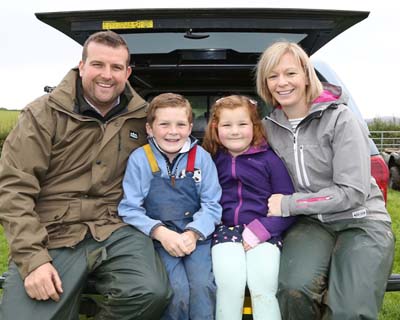As a new and ambitious farm business, involvement in the Monitor Farm programme has provided the technical support to drive sustainable expansion at Clonhie Farm, Nithsdale.
Over the three-year programme, Andrew and Aileen Marchant have drawn on the advice of the Monitor Farm network to boost output per hectare. This has led to improvements in grassland management, resulting in an 18% uplift in dry matter yield per hectare,and allowed ewe stocking rates to be increased by 30% and a herd of deer to be introduced. The farm’s carbon footprint has subsequently dropped by 25%.
“The Monitor Farm programme has given us a better understanding of how to intensify our business sustainably and in a profitable manner,” explained Mr Marchant at the final meeting of the programme.
Clonhie Farm is one of nine monitor farms established in Scotland as part of a joint initiative by QMS and AHDB Cereals & Oilseeds, with funding from the Scottish Government. The aim of the monitor farm programme is to help improve the productivity, profitability and sustainability of Scottish farm businesses.
The Marchants started out as new entrants in 2012. Since then, they have undergone rapid expansion on the 300ha farm, which is owned by the Buccleuch Estate. Having started with 12 sheep, they now have a flock of 1,000 ewes, 30 pedigree Luing cows and 175 red deer.
Throughout the Monitor Farm programme, the family has adopted a multi-pronged approach to increasing performance. This has focused on grassland management and ewe genetics.
Lime has been applied to some of the farm’s best ground to raise soil pH and grassland has been improved by direct drilling. Rape and kale are now used as an entry for a full grass reseed, whilst providing cost-effective winter keep.
Rotational grazing, rather than set-stocking, has also benefited grass yields. Deferred grazing, where grassland is shut up from the end of August until January/February, has proved a revelation and reduced the cost of keeping ewes in condition through the winter.
Mr Marchant explained: “When we tested the grass on 21st January, crude protein was 21% at 11.2ME. To buy that level of concentrate would be expensive. It’s been a real eye opener for everyone in the group.”
Better grass quality has reduced concentrate requirements and subsequently costs, although Mr Marchant explained that he is not afraid to feed, as long as the sums add up.
“We’re a lot more targeted with feed and fertiliser now. I’ve always had the mentality that everything we do has to show a return, but we’re a bit more thorough and more scientific. We’ve just upped our game,” Mr Marchant added.
A change in ewe breeding policy is also part of the farm’s long-term goals to make better use of forage and improve output. The Marchants have now closed the flock and are moving away from North Country Cheviot x Lleyns and Texel x ewes to Aberfields and Highlanders. Targeted culling is also being adopted to ensure they only breed replacements from the best animals. This was also identified as a crucial strategy to reduce lameness.
Having faced ‘The Beast from The East’ in 2018 and identified triclabendazole resistance in ewes the following season, lambing percentages are yet to improve. However, Mr Marchant is confident about the future. “We expect to see benefits on the bottom line in the next 2-3 years. We’re very positive and happy about where we are,” he said.
Programme facilitator, Judith Hutchinson, said the farm had made big strides by addressing numerous small things that created a “multiplier effect”.
“It’s multifactorial. I believe Andrew is on the brink of taking off. I think there will be considerable improvements in financial performance, productivity, sustainability and environmental footprint over the next few years,” she told the group.





